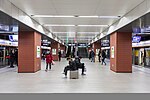Foreign Languages Press
Foreign Languages Press is a publishing house located in China. Based in Beijing, it was founded in 1952 and currently forms part of the China International Publishing Group, which is owned and controlled by the Publicity Department of the Chinese Communist Party. The press publishes books on a wide range of topics in eighteen languages spoken primarily outside China. Much of its output is aimed at the international community – its 1960s editions of works by Marx and Lenin are still widely circulated – but it also publishes some material aimed at foreign language students within China. Beginning in the 1950s many works of classical and modern Chinese literature were translated into English by translators such as Gladys Yang, Yang Xianyi and Sidney Shapiro.As of 2008, the house had published over 30,000 titles in a total of 43 languages.
Excerpt from the Wikipedia article Foreign Languages Press (License: CC BY-SA 3.0, Authors).Foreign Languages Press
Baiwanzhuang Str, Xicheng District 黄瓜园社区 (首都功能核心区)
Geographical coordinates (GPS) Address Nearby Places Show on map
Geographical coordinates (GPS)
| Latitude | Longitude |
|---|---|
| N 39.926388888889 ° | E 116.33222222222 ° |
Address
百万庄大街
Baiwanzhuang Str
100032 Xicheng District, 黄瓜园社区 (首都功能核心区)
Beijing, China
Open on Google Maps










